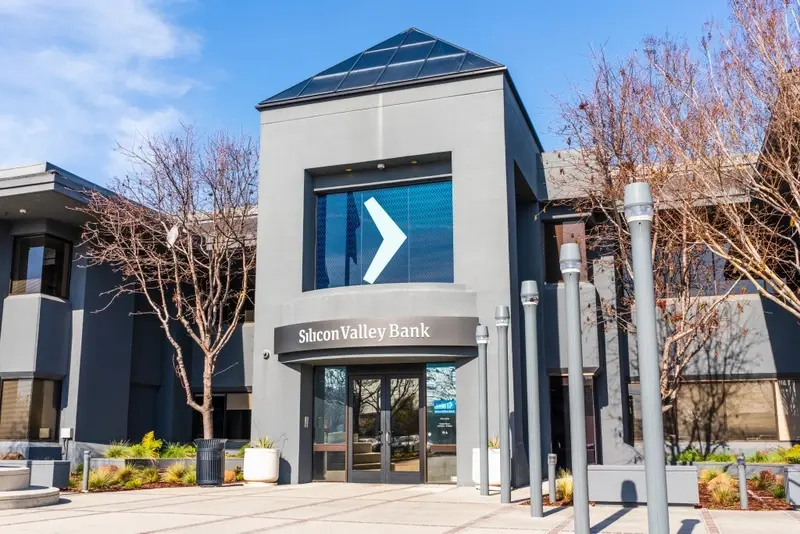
US markets were rocked on Thursday as Silicon Valley Bank shares collapsed 60%. Officially SVB Financial (SIVB:NASDAQ), it has become synonymous with lending to high-risk technology start-ups, many of which are increasingly desperate for cash as venture capital funding has dried up.
This has led to pressure on Silicon Bank's liquidity and vast bond sales, forcing it to go cap in hand to investors for $1.75 billion of fresh funding via a share sale to cover bond sale losses.
The news sent regional banking shares down over 8%, which spilled over into UK and European trading. The UK's big banks fell around 5% in early trading on Friday (10 Mar), led by HSBC's (HSBA) 5.5% decline.
It caps off a poor week for equities after the Humphrey-Hawkins testimony by Fed chair Jerome Powell set the tone. Yet again Powell confounded unbelievers in the Fed's tough monetary stance to bring down inflation.
On Wednesday the monthly job openings report drove the message even deeper showing openings fell less than expected and the prior month was revised higher, pointing to a continued tight labour market.
After January's blow-out 517,000 jobs number (185k expected) investors will be hoping for a much lower reading in February when the data drops at 1.30 pm UK time today. The consensus is expecting 205,00 jobs.
GAP
Shares in US clothing chain Gap (GPS:NYSE) ‘gapped’ 8.2% lower to $10.63 in after-hours trading as the company behind the eponymous store chain as well as the Old Navy, Banana Republic and Athleta brands reported disappointing fourth quarter results (9 March).
Investors were also rattled by news of a number of executive changes as Gap's quest to find a permanent CEO continues. For the three months to 28 January 2023, Gap's net loss widened from $16 million a year earlier to $273 million.
This translated into a loss per share of $0.75 per share, worse than the $0.46 loss forecast by analysts. Revenue of $4.24 billion was 6% lower year-on-year and shy of the $4.36 billion expected by analysts. Comparable sales were down 5% year-on-year as physical store sales decreased by 3% and online sales plunged 10%.
On the bright side Gap, which has struggled with bloated inventories, finished the year with $2.39 billion of inventory, a 21% year-on-year reduction, but the outlook for fiscal 2023 was downbeat, based on the ‘continued uncertain consumer and macro environment’.
Gap expects full year 2023 sales could decrease in ‘the low to mid-single digit range’ versus last year's $15.6 billion, although the apparel retailer does expect gross margins to expand in the first quarter and throughout the year.
CROWDSTRIKE
The cybersecurity stocks space has been hit and miss in recent months as guidance has often dulled otherwise strong earnings, but not so Crowdstrike (CRWD:NASDAQ). It saw its share price surge 6% directly after reporting fourth-quarter results that topped Wall Street estimates and the company issued better-than-expected full-year guidance as ongoing cybersecurity demand spurred new business wins.
This is the world's third-largest cybersecurity company worth $28.5 billion, and it is a pioneer of cloud-delivered endpoint protection and advanced threat intelligence.
EPS (earnings per share) of $0.47 on $637.4 million were posted for Q4 of fiscal 2023 (to 31 Jan), beating Wall Street's consensus of $0.43 and $624.7 million respectively. The earnings beat was driven by a surge in new customer subscriptions that pushed average recurring revenue, or ARR, to record levels in the quarter.
As for guidance, Crowdstrike forecast EPS of between $2.21 to $2.39 on revenue of $2.95 billion to $3.01 billion, above Wall Street forecasts pitched at $2.02 and $2.97 billion respectively.
CAMPBELL SOUP
Despite good news flow, shares in Campbell Soup (CPB:NYSE) continue to suffer from indigestion.
Second quarter results on 8 March were better than expected, with $0.80 earnings per share versus estimates of $0.74. Full-year sales growth guidance of 8.5% to 10% was also better than the analyst consensus of 8.3%.
One would have thought that was enough to lift the shares out of their rut, but a mere 2% rise on the day of the results then turned into a decline the following day. Year-to-date they're down nearly 7% versus a 2.5% rise in the S&P 500.
Admittedly they had a great run in 2022 and investors are now taking a more risk-on approach with stock picking and taking profits from defensive companies like the soup maker.
Defensives could easily come back into fashion if US interest rates keep going up and cause problems to the US economy as investors would hide in stocks whose products and services are in demand in good and bad times.




